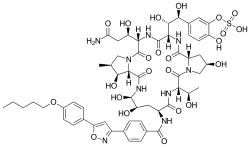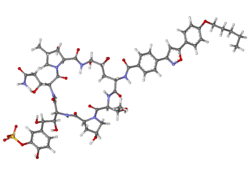Micafungin
 | |
 | |
| Clinical data | |
|---|---|
| Trade names | Mycamine |
| AHFS/Drugs.com | Monograph |
| License data |
|
| Pregnancy category |
|
| Routes of administration | Intravenous |
| ATC code | |
| Legal status | |
| Legal status |
|
| Pharmacokinetic data | |
| Protein binding | 99.8% |
| Metabolism | Via catechol-O-methyltransferase pathway |
| Elimination half-life | 11–17 hours |
| Excretion | 40% feces, <15% urine |
| Identifiers | |
| |
| CAS Number | |
| PubChem CID | |
| DrugBank | |
| ChemSpider | |
| UNII | |
| KEGG | |
| ChEMBL | |
| Chemical and physical data | |
| Formula | C56H71N9O23S |
| Molar mass | 1270.28 g/mol |
| |
| | |
Micafungin (trade name Mycamine) is an echinocandin antifungal drug used to treat and prevent invasive fungal infections including candidemia, abscesses and esophageal candidiasis. It inhibits the production of beta-1,3-glucan, an essential component of fungal cell walls. Micafungin is administered intravenously. It received final approval from the U.S. Food and Drug Administration on March 16, 2005, and gained approval in the European Union on April 25, 2008.
Indications
Micafungin is indicated for the treatment of candidemia, acute disseminated candidiasis, Candida peritonitis, abscesses and esophageal candidiasis. Since January 23, 2008, micafungin has been approved for the prophylaxis of Candida infections in patients undergoing hematopoietic stem cell transplantation (HSCT).
Micafungin works by way of concentration-dependent inhibition of 1,3-beta-D-glucan synthase resulting in reduced formation of 1,3-beta-D-glucan, which is an essential polysaccharide comprising one-third of the majority of Candida spp. cell walls. This decreased glucan production leads to osmotic instability and thus cellular lysis. [1] [2]
Contraindications
Known hypersensitivity to micafungin or any other ingredient contained in the formulation is a contraindication for its use.
Dosage
The metabolism of micafungin occurs hepatically as the drug molecule is a substrate of CYP3A4, a liver enzyme. Precautions should be taken with regards to dosing, as micafungin also inhibits its own clearance via weak CYP3A4 inhibition.[3][4]
Dosage forms
Micafungin is a natural antifungal product derived from other fungi as a defense mechanism for competition of nutrients, etc. To be specific, micafungin is derived from FR901379, and is produced by Coleophoma empetri.[5][6]
References
- ↑ Pappas, P. G.; Rotstein, C. M.; Betts, R. F.; Nucci, M; Talwar, D; De Waele, J. J.; Vazquez, J. A.; Dupont, B. F.; Horn, D. L.; Ostrosky-Zeichner, L; Reboli, A. C.; Suh, B; Digumarti, R; Wu, C; Kovanda, L. L.; Arnold, L. J.; Buell, D. N. (2007). "Micafungin versus caspofungin for treatment of candidemia and other forms of invasive candidiasis". Clinical Infectious Diseases. 45 (7): 883–93. doi:10.1086/520980. PMID 17806055.
- ↑ Pettengell, K; Mynhardt, J; Kluyts, T; Lau, W; Facklam, D; Buell, D; FK463 South African Study Group (2004). "Successful treatment of oesophageal candidiasis by micafungin: A novel systemic antifungal agent". Alimentary Pharmacology and Therapeutics. 20 (4): 475–81. doi:10.1111/j.1365-2036.2004.02083.x. PMID 15298643.
- ↑ Carver, P. L. (2004). "Micafungin". Annals of Pharmacotherapy. 38 (10): 1707–21. doi:10.1345/aph.1D301. PMID 15340133.
- ↑ Kohno, S; Masaoka, T; Yamaguchi, H; Mori, T; Urabe, A; Ito, A; Niki, Y; Ikemoto, H (2004). "A multicenter, open-label clinical study of micafungin (FK463) in the treatment of deep-seated mycosis in Japan". Scandinavian Journal of Infectious Diseases. 36 (5): 372–9. doi:10.1080/00365540410020406. PMID 15287383.
- ↑ Hashimoto, S (2009). "Micafungin: A sulfated echinocandin". The Journal of Antibiotics. 62 (1): 27–35. doi:10.1038/ja.2008.3. PMID 19132058.
- ↑ Fujie, Akihiko (2007). "Discovery of micafungin (FK463): A novel antifungal drug derived from a natural product lead". Pure and Applied Chemistry. 79 (4). doi:10.1351/pac200779040603.
External links
- Mycamine website, run by Astellas Pharma US
- Mycamine Prescribing Information
- Eschenauer, G; Depestel, D. D.; Carver, P. L. (2007). "Comparison of echinocandin antifungals". Therapeutics and Clinical Risk Management. 3 (1): 71–97. doi:10.2147/tcrm.2007.3.1.71. PMC 1936290. PMID 18360617.